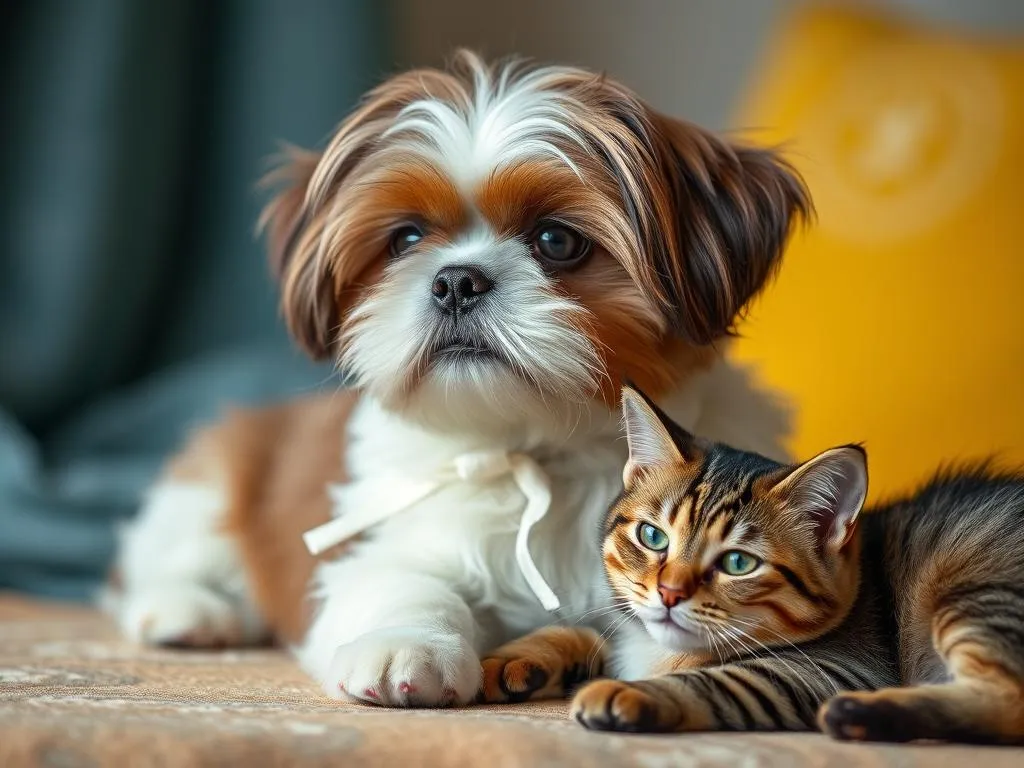
Introduction
The Shih Tzu is a small, affectionate breed known for its charming personality and regal appearance. Originating from Tibet, these dogs have a rich history as companions to Chinese royalty, which contributes to their luxurious coat and dignified demeanor. Shih Tzus are typically friendly, playful, and eager to please, making them beloved pets for families and individuals alike.
When considering introducing a Shih Tzu into a home that already has a cat, understanding the compatibility of these two pets is crucial. This article will assess whether Shih Tzus are good companions for cats, exploring their characteristics, behaviors, and the dynamics of their interactions.
Understanding the Shih Tzu Breed
Characteristics of Shih Tzus
-
Size and Physical Appearance: Shih Tzus are small dogs, typically weighing between 9 to 16 pounds and standing 9 to 10.5 inches tall. They have a distinctive long, flowing coat, often requiring regular grooming to prevent matting.
-
Coat Types and Grooming Needs: Their double coat can be either straight or slightly wavy, and many owners opt for regular trims to maintain a manageable length. Daily brushing is recommended to keep their fur healthy and to reduce shedding.
-
Common Health Issues: Like many purebred dogs, Shih Tzus are prone to certain health issues, including brachycephalic airway syndrome, hip dysplasia, and eye problems. Regular veterinary check-ups are essential to monitor their health.
Temperament and Behavior
-
General Disposition: Shih Tzus are known for their friendly and affectionate nature. They thrive on companionship and tend to form strong bonds with their human families.
-
Socialization Tendencies with Other Animals: Generally, Shih Tzus can be socialized to get along with other pets, including cats, especially if introduced early in life.
-
Energy Levels and Playfulness: While they enjoy playtime, Shih Tzus are not overly energetic, making them suitable for both active and more relaxed households.
Understanding Cats
Characteristics of Common Domestic Cats
-
Size and Physical Traits: Domestic cats vary in size, typically ranging from 5 to 20 pounds. They possess a range of coat colors and patterns, with short-haired and long-haired varieties.
-
Various Personality Types in Cats: Cats can have diverse personalities, from playful and social to independent and aloof. Understanding your cat’s unique temperament is crucial when introducing a new pet.
General Cat Behavior
-
Territorial Instincts: Cats are naturally territorial animals. They often feel more secure in their environment and may be wary of new animals invading their space.
-
Social Dynamics with Other Animals: While some cats may enjoy the company of dogs, others may prefer solitude. Their behavior can significantly influence how well they adapt to a new canine companion.
-
Common Signs of Stress or Aggression in Cats: Signs of stress in cats can include hiding, hissing, or swatting. Recognizing these behaviors is essential for ensuring both pets feel safe during interactions.
Assessing Compatibility Between Shih Tzus and Cats
Temperament Comparison
-
Similarities Between Shih Tzus and Cats: Both Shih Tzus and cats can be affectionate and playful, often enjoying companionship without being overly demanding. This common ground can facilitate a smoother introduction.
-
Differences That May Affect Interactions: However, Shih Tzus are often more social and eager to engage, while cats may be more reserved, leading to potential misunderstandings during their initial meetings.
Socialization and Training
-
Importance of Early Socialization for Shih Tzus: Early socialization is crucial for Shih Tzus to develop good manners and become accustomed to various animals, including cats. Exposing them to cats at a young age can promote positive interactions.
-
Tips for Introducing a Shih Tzu to a Cat:
- Controlled Introductions: Start by allowing the Shih Tzu to sniff the cat’s bedding or toys to familiarize themselves with the cat’s scent.
- Use of Barriers: Consider using baby gates or crates to keep them separated initially while allowing them to see and smell each other.
-
Supervised Meetings: Gradually introduce them in a controlled environment, monitoring their reactions closely.
-
Managing Interactions: Positive Reinforcement Techniques: Use treats and praise to reinforce calm behavior during their interactions. This approach can help both pets associate each other with positive experiences.
Case Studies and Personal Experiences
Success Stories
Many pet owners report positive experiences with Shih Tzus and cats cohabiting peacefully. For instance, one owner shared how their Shih Tzu quickly adapted to living with their older cat by respecting her space and engaging in gentle play.
- Tips from Pet Owners:
- Allow the cat to have safe spaces where it can retreat if it feels overwhelmed.
- Ensure that both pets have their own feeding areas to reduce competition for resources.
Challenges Faced
While many Shih Tzus and cats can live harmoniously, there may be challenges during the introduction phase. Some common issues include:
-
Chasing Behavior: Shih Tzus have a playful nature, which may be perceived as aggression by a cat. This behavior can lead to stress for the cat.
-
Resource Guarding: Both pets may exhibit protective behaviors over their food, toys, or sleeping areas.
-
Strategies to Overcome These Challenges:
- Training the Shih Tzu to respond to commands can help manage chasing tendencies.
- Creating separate feeding and resting areas can minimize conflict over resources.
Expert Opinions and Research
Veterinarian Insights
Veterinarians often emphasize the importance of understanding individual personalities when assessing compatibility between a Shih Tzu and a cat. Professional advice underscores the need for patience during the introduction phase and suggests observing body language closely to gauge comfort levels.
Research Studies
Research on dog-cat interactions indicates that successful coexistence often hinges on early socialization and gradual introductions. Studies have shown that dogs with histories of living with cats tend to display more tolerant behaviors, underscoring the importance of early experiences.
Final Thoughts
Summary of Key Points
In conclusion, Shih Tzus can indeed be good companions for cats, provided that their unique characteristics and behaviors are taken into account. Their friendly demeanor and affectionate nature often complement the more independent personality of cats. However, careful introductions and training are essential to ensure a harmonious relationship.
Recommendations for Potential Owners
Before adopting or introducing a Shih Tzu into a household with a cat, consider the following:
- Assess the individual personalities of both pets.
- Prepare your home for a gradual introduction, ensuring that both animals have safe spaces.
- Remain patient and observant during their interactions to foster positive relationships.
By understanding both breeds’ unique traits, you can create a loving environment where both your Shih Tzu and cat can thrive together.









